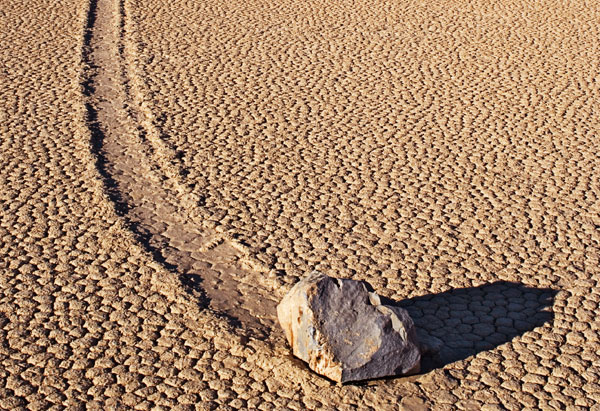10 Marvels of Our World

Photo: Dennis Flaherty/Getty Images
PAGE 3
Death Valley's Sailing Stones
Imagine rocks weight up to several hundred pounds gliding from one spot to another, all by themselves. This has been known to happen in the middle of the Mojave Desert, on a sun-baked lake bed called Racetrack Playa. Although no one has ever actually seen the rocks in motion, we know they move because of the tracks they leave—sometimes straight paths, sometimes curved trails nearly 3,000 feet long. Researchers hypothesize that a precise recipe of elements is responsible: Melting snow from the surrounding mountains runs into the playa below, turning dry clay into slick mud. As temperatures plummet at night, a rim of ice forms around the base of the playa's rocks. As more water flows in, the ice floats the rocks ever so slightly. Then come the winds. Gusts of 50 miles per hour or more set the stones sailing. —Crystal Martin
The Morning Glory Cloud
The glider pilots who surf the Morning Glory call it "heavenly." Its technical description is "roll cloud"—an extremely rare atmospheric formation that flows backward as it moves forward, stretching as far as 600 miles across the horizon. Scientists don't entirely understand the physics behind the cloud's formation, but the conditions in Australia's Gulf of Carpentaria in September and October are perfect for summoning it: In the early evening, westerly breezes from the gulf and easterly ones from the Coral Sea collide over a peninsula, creating a tubular wave of air. Thanks to the area's high humidity, the moisture in the air condenses to form this breathtaking spectacle in the sky. —C.M.
The Underground Orchid
The more than 22,000 species of the orchid family are known for growing in exotic and hard-to-reach places. But Rhizanthella gardneri is one of the most elusive. It blooms in buried darkness. With no chlorophyll, the tiny plant seems to rely upon a symbiotic fungus that steals nutrients from nearby shrubs. In late May, the orchid's stem grows a head filled with up to 100 miniflowers, which draw insects like gnats and termites down into the soil for pollination. Today fewer than 50 of these plants are known to exist. —Jessica Sylvester
Next: An island that gets overtaken by crabs—every single year
Imagine rocks weight up to several hundred pounds gliding from one spot to another, all by themselves. This has been known to happen in the middle of the Mojave Desert, on a sun-baked lake bed called Racetrack Playa. Although no one has ever actually seen the rocks in motion, we know they move because of the tracks they leave—sometimes straight paths, sometimes curved trails nearly 3,000 feet long. Researchers hypothesize that a precise recipe of elements is responsible: Melting snow from the surrounding mountains runs into the playa below, turning dry clay into slick mud. As temperatures plummet at night, a rim of ice forms around the base of the playa's rocks. As more water flows in, the ice floats the rocks ever so slightly. Then come the winds. Gusts of 50 miles per hour or more set the stones sailing. —Crystal Martin
The Morning Glory Cloud
The glider pilots who surf the Morning Glory call it "heavenly." Its technical description is "roll cloud"—an extremely rare atmospheric formation that flows backward as it moves forward, stretching as far as 600 miles across the horizon. Scientists don't entirely understand the physics behind the cloud's formation, but the conditions in Australia's Gulf of Carpentaria in September and October are perfect for summoning it: In the early evening, westerly breezes from the gulf and easterly ones from the Coral Sea collide over a peninsula, creating a tubular wave of air. Thanks to the area's high humidity, the moisture in the air condenses to form this breathtaking spectacle in the sky. —C.M.
The Underground Orchid
The more than 22,000 species of the orchid family are known for growing in exotic and hard-to-reach places. But Rhizanthella gardneri is one of the most elusive. It blooms in buried darkness. With no chlorophyll, the tiny plant seems to rely upon a symbiotic fungus that steals nutrients from nearby shrubs. In late May, the orchid's stem grows a head filled with up to 100 miniflowers, which draw insects like gnats and termites down into the soil for pollination. Today fewer than 50 of these plants are known to exist. —Jessica Sylvester
Next: An island that gets overtaken by crabs—every single year



